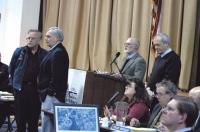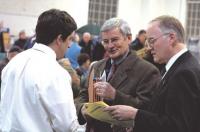
Serving the Vermont Champlain Valley Area for 45 Years
Main SectionsFront Page SportsValley VitalsIt's in the StarsStarwiseArchivesLinksAbout The VoiceContact Us |
Town Meeting Of Minds: Middlebury Makes Legislative History For Reshaping DowntownTuesday March 11, 2008 By Ed Barna When questions arise about the interpretation of laws, those seeking answers go to the legislative history behind what was enacted. When the future looks back at Town Meeting 2008, they will see the substantial margins with which two key special articles passed: 1,535-829 for bonding to build a second in-town bridge; and 1,358-829 for a charter change enabling a 1 percent local tax to be added to one or more of the current taxes on sales and use, rooms, meals, and alcoholic beverages. Fro that, they may conclude that the measures easily sailed through. But in fact the floor meeting Monday, attended by roughly 250 residents included a thorough examination of those two measures, which would be voted the following day by Australian ballot. (The proposed $6,383,774 budget, up about 5.8 percent, went through an equally compressive wringer before getting voice vote approval with only scattered nays.) With Selectboard chairman John Tenny and member Dean George doing tag team duty as explicators, there was a chance for voters to resolve uncertainties and emphasize key points. First, approval of the charter change measure does not create the local option tax, or even a charter change. The Legislature must first approve the charter alteration, after which the Select Board will decide which taxes to enact and whether to sunset them—with the public having plenty of input, Tenny promised. The current tax rates, Selectman George noted, are 6 percent for sales and use (citizens and businesses are supposed to pay the equivalent of the sales tax on their out-of-state purchases); 9 percent for rooms and for meals; and 10 percent for alcohol. Perhaps of interest to those wondering if the added levy would push shoppers northward, he observed that Burlington, South Burlington, and Williston all have such option taxes. That article’s new revenue source related to the article authorizing bonding for up to $16 million to build the Cross Street Bridge, the sum possibly to be reduced by other sources of funding (i.e. state or federal money—Middlebury College has promised to help with the bond payments). The bonding would take place in two stages: $4 million would be for design, permitting, engineering, and property acquisition; then, with the permits and rights-of-way in place, $12 million would finance actual construction. Tenny said that in practice, short-term tax anticipation notes could be used to accomplish the steps covered by the $4 million of bonded debt. One resident asked about Middlebury’s bond rating, and was told that the local bonds go into the state bond bank, which has an AAA rating. Middlebury College has pledged $600,000 a year over the course of the 30 years of bond repayment, Tenny said—an amount which at first would be les than half of the annual payment (that cost would be highest in the second year then would decline each year) but by the end would more than cover the annual sum. The Vermont Department of Taxes has calculated that if Middlebury had used all four possible option taxes in 2007, they would ha netted $725,319. When someone pointed out that 30 times $600,000 equals $18 million, Tenny said that the 30-year cost of the project, including interest, would amount to $26,785,566—“approximately.” This may have been one of the few times in Vermont that the announcement of a heavy debt burden was greeted with hearty laughter. George said they have already assembled a construction team, one that has proved itself doing bridges in Woodstock, Bethel, Glens Falls, and between South Burlington and Colchester. Because the Cross Street site has been targeted for so long, and because there have already been talks with property owners, the goal is to do all the permitting and preliminary engineering this year, he said. In other words, George said, by the end of 2010, the bridge could be complete. There would be three spans of 165 feet each, with two piers at the two sides of Otter Creek; along the roadway, there would be 11-foot travel lanes and four-foot shoulders (these are the same specifications for the in-town parts of the Brandon and Pittsford Route 7 rehabilitation project) plus six-foot sidewalks. Asked about designating bike ways, to alert motorists, George said that would entail meeting federal standards for the shoulders, which would greatly inflate the price of the project. Someone questioned whether the vote in favor of the Cross Street location had been a clear enough expression of what the townspeople wanted; the board thought the 695-203 margin in that vote, more than 3 to 1, was decisive enough. One speaker suggested that using solar panels to power the bridge’s streetlights would save money, keep the lights during any power outage, and in regard to the environment it would “really stand out that the town is taking a leadership role.” The town spends $79,000 on streetlights annually, and solar power would help bring that down, he said. Anyone who wants to see such lights can take Route 22A down into Granville, New York, he added. Tenny recalled how town officials met with Secretary of Transportation Dawn Terrell in September of 2005 and instead of getting support for the in-town bridge learned that the State wanted to cause massive disruption of the business district by putting an unsuitable new Merchants Row bridge over the But actually, Cross Street has been postponed far longer than that, George said. Back in 1955, the State Highway Department issued a report on how congested Main Street/Route 125 had become, and recommended another bridge “at the same location” as the current project, he said. George, who at one point received a standing ovation for his hard work on the project, urged voters to back it. “We have a very unique opportunity to make this more than 50 year old project actually happen,” he said.
|
AdvertisementsSearch our Archives |
Agricultural Weather Forecast:

© 2006-18 The Valley Voice • 656 Exchange St., Middlebury, VT 05753 • 802-388-6366 • 802-388-6368 (fax)
Valleywides: [email protected] • Classifieds: [email protected] • Info: [email protected]


 Printer Friendly
Printer Friendly